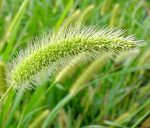A lso known as green bristlegrass and foxtail millet, green foxtail is an annual grass and a member of the grass family, Poaceae, that also includes corn, rice, and bamboo. It is native to Eurasia but was introduced to the US and now occurs throughout the US in areas with sun to part shade and moist to dry-mesic conditions. Plants can be found in a variety of habitats including vacant lots, sidewalks, railroads, lawns, croplands, pastures, prairies, and grasslands.
lso known as green bristlegrass and foxtail millet, green foxtail is an annual grass and a member of the grass family, Poaceae, that also includes corn, rice, and bamboo. It is native to Eurasia but was introduced to the US and now occurs throughout the US in areas with sun to part shade and moist to dry-mesic conditions. Plants can be found in a variety of habitats including vacant lots, sidewalks, railroads, lawns, croplands, pastures, prairies, and grasslands.
Description: Green foxtail is usually a clump forming grass growing one to three feet tall from a shallow fibrous root system. The upright, ascending or spreading stems (culms) are hollow, hairless and light green. They carry leaves that are light to medium green, hairless, and up to six inches long. The leaf sheaths are often purplish at the base and the ligules are marked by white hairs. The flowers are carried in dense terminal spike-like panicles that are light green, two to four inches long, and often slightly nodding. The many hairs contained in the spike cause it to resemble the tail of a fox, hence the common name. Although the spike looks fuzzy, the tips of the hairs are barbed. Green foxtail blooms from late spring to early fall but individual plants bloom only for one to three weeks during that time and each flower produces a single seed that remains viable in the soil for up to forty years. Plants reproduce by seed.
Control: Mulch to inhibit seed germination. Hoe or pull seedlings as they appear and pull, hoe, or mow larger plants before they set seed. Patience, diligence and persistence will be needed because of the long bloom time and many ears of seed viability. In severe cases preemergent herbicides and/or postemergent herbicides may be necessary depending on the habitat and other vegetation.